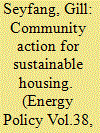|
|
|
Sort Order |
|
|
|
Items / Page
|
|
|
|
|
|
|
| Srl | Item |
| 1 |
ID:
177492


|
|
|
|
|
| Summary/Abstract |
The supply side of sustainable housing needs to be complemented with, driven by, and shaped around a willing and committed demand site. This study examines the sustainable housing sector of Pakistan by describing the potential buyers’ profile and quantifying their willingness to pay (WTP) for sustainable housing uptake in the market. WTP is estimated through a survey of 354 potential homebuyers. Furthermore, the hierarchical Bayesian model of adaptive choice-based conjoint analysis is utilized to study the correlation of descriptive determinants on WTP for sustainable housing. The results suggest that demographical factors of age, gender, and literacy level positively correlate with WTP whereas environmental knowledge and income level negatively correlate with WTP. Also, energy saving has the highest relative importance among other housing attributes. The study contributes a vital empirical input to the literature by finding the potential sustainable homebuyers in Pakistan and their characteristics and proposes several policy guidelines to promote the uptake of the sustainable housing sector in the country.
|
|
|
|
|
|
|
|
|
|
|
|
|
|
|
|
| 2 |
ID:
175925


|
|
|
|
|
| Summary/Abstract |
As the impacts from climate change are progressively being felt around the globe, there is an increasing urgency in the need for policymakers to find ways to reduce greenhouse gas emissions. The rental housing sector offers one such clear opportunity to reduce CO2 emissions. However, there has been a lack of consensus regarding the policies that would best deliver a sustainable rental sector. Building on calls in the literature to examine policy mix solutions for this conundrum, a Policy Delphi methodology, using both qualitative and quantitative techniques, identified seven key policy areas. These were divided into carrot policies (tax incentives, rebates and grants); cusp policies, that are neither clearly carrot nor stick, but often have a leaning towards one or other (loans, energy arrangements, improved rental rights); and stick policies (minimum standards, mandatory disclosure). Minimum performance standards, rebates and tax incentives were identified as the most effective policy solutions by the expert panel. Findings suggest that any policy mix should include both carrot and stick policies. When integrated with the existing ‘enabling forces’ literature, a model emerges that highlights the policy pathways to an environmentally sustainable rental housing sector.
|
|
|
|
|
|
|
|
|
|
|
|
|
|
|
|
| 3 |
ID:
101455


|
|
|
|
|
| Publication |
2010.
|
| Summary/Abstract |
This paper presents a new analytical framework of 'grassroots innovations' which views community-led initiatives for sustainable development as strategic green niches with the potential for wider transformation of mainstream society. This framework is applied to a low-carbon, low-impact, community-based sustainable housing initiative in the USA that pioneers straw bale housing techniques within a strong community-building ethos. The project is evaluated according to New Economics criteria of sustainable consumption, and is found to be successful at localising the construction supply chain, reducing ecological footprints, community-building, enabling collective action and building new institutions and systems of provision around housebuilding. However, viewing it as a strategic niche with aim to influence wider society, it is clear that it faces significant challenges in diffusing its ideas and practices beyond the niche. Its model is not necessarily suitable for scaling up or widespread replication; however, the scope for niche lessons to be adopted by mainstream builders is greater, given a supportive policy environment. Recognising the innovative nature of green niches at the policy level could lead to new approaches to governance of bottom-up community action for sustainable development.
|
|
|
|
|
|
|
|
|
|
|
|
|
|
|
|
|
|
|
|
|